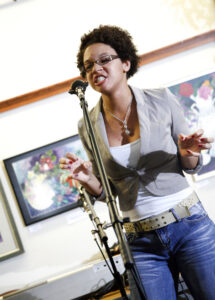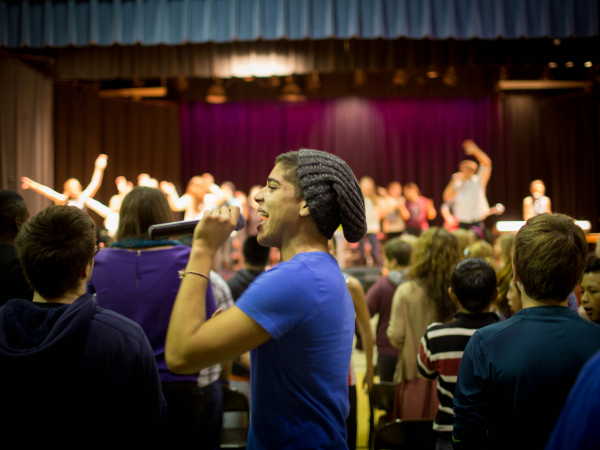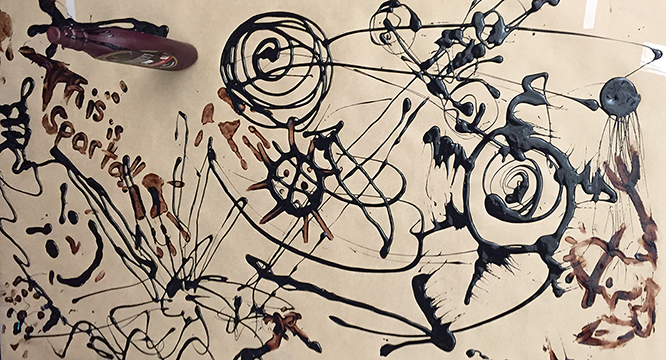In this workshop, poetry collective Flatline Poetry uses poetry to get students more comfortable with public speaking. The lesson helps students prepare for everything from presenting in the classroom to appearing before larger audiences and can be adapted for use in getting students ready for Poetry Out Loud competitions.

This lesson plan is designed for classroom teachers who want to teach performance, or for visiting teaching artists looking for additional activities to add to their lessons. The poem Flatline Poetry used was Always Something More Beautiful by Stephen Dunn. This poem can be replaced by another text in an existing curriculum or another selection from the Poetry Out Loud anthology.
LESSON
Prepare for this workshop by selecting two poems, one example poem to play for the class as an introduction to performance poetry, and one poem students will explore during the workshop. Good sources of poems include:
- SlamFind
- Button Poetry (especially their playlist of classroom-friendly poems)
- A poem from The Breakbeat Poets
- A poem from Poetry Out Loud’s anthology of poems. (Specifically for teachers preparing for Poetry Out Loud.)
- A poem you are already covering in your humanities or English class
Things to consider when selecting a poem:
- Know your students! Select poems and authors that your students can relate to.
- Use this as an opportunity for variety. If you have been covering a lot of male poets, for example, consider using this as an opportunity to highlight writers of other genders and/or non-binary poets.
Introduction: Begin by either performing the first poem or by showing an example of the poem being performed. We recommend using SlamFind or Button Poetry to find performance videos.
Explain that this is a workshop on performance and inform students that they will not be forced to perform on their own in front of the class if they don’t want to. For students with social anxiety, or any fears around public speaking, it can be helpful to put their minds at ease right at the start of the class.
Activity #1: Exploring the poem: Hand out copies of the second poem you selected, making sure the font is a little larger than typical (14 or 15 font, or larger depending on the needs of your students) with space enough between lines so it’s easy to underline, circle, or make notes. Read the poem out loud for your students and ask them to underline lines that stand out to them. Next, go around the room and ask students to share some of the lines that stood out. Discuss the poem. What was the narrator feeling during different moments in the poem? What emotions might be conveyed through performance choices? After the discussion, invite students to read the poem aloud in their own way. Have one or two students try this out. During each student’s reading, assign (or ask for volunteers) two students to listen and provide two examples of things they liked about that student’s performance of the poem.
NOTE: This is a great way to keep students engaged while other students are performing. If you have students in your class who struggle with attention, assigning them to give positive feedback to their peers can be a great way to get them dialed in.
Activity #2a: “I’m Going Downtown”: Have students form a circle in the classroom, on their feet (all chairs and tables pushed aside). Begin by saying “I love you” three times: emphasizing a different word each time. (For example: “I love you,” “I love you,” and then “I love you.”) Ask the students to identify the difference between the three sentences. Illustrate the point that putting emphasis on different words can change the entire meaning of a linear phrase
Next, have students go around the circle and say “I’m going downtown.” The only rule is that they have to say it differently from everyone who went before them. After each student speaks, the whole circle repeats the phrase in the exact same way the student performed it. (They might adjust their volume, or emphasize a different word.) Go around again, and this time have students add a physical gesture while they say the sentence.
Activity #2b: Tongue Twister: Depending on the time you have allotted for this lesson plan, you may need to choose between I’m Going Downtown and the Tongue Twister. These can each also be stand-alone activities used to open up a second day of performance work.
Teach the students a tongue twister. (Flatline likes Mother Pheasant Plucker) Once the whole group is comfortable with saying the tongue twister, have them try it in different way. For example: “Say it as if you are in a huge fight with your best friend,” and then, “as if you are in a huge fight with your best friend and you are both sneaking back into your house,” or “as if you just got the job as the pheasant plucker,” and then “as if you just got the job as the pheasant plucker and you are telling your friend who didn’t get the job.” The different ways can be as complex or as simple as you want. A good way to do this it to have students break into pairs and say the words to each other simultaneously, or have them all say it at once to the center of the room, NOT one at a time.
NOTE: For classrooms with a large population of students who struggle to focus or a large group of shy students, begin this activity in the circle and then have students walk around the room while they are talking. Students tend to get more comfortable when they don’t feel they are being stared at by their peers.
Activity #3: Perform to the wall: NOTE: This is a great first step for students who are nervous about reading or sharing in front of the entire class.
Have students grab their copies of the poem and find a spot on the wall. Instruct students to begin reading the poem out loud to the wall on the count of three. Have students try it a few times, reading the poem in different ways each time.
Closing: At the end of the workshop, ask if there are any volunteers who want to perform the poem for the whole class. Have them perform and ask two of their peers to share one piece of positive feedback about the performance. Close the workshop by having all the students form a circle and perform the poem to the center of the room in unison.
Founded on the belief that poetry is stronger in community, Flatline Poetry is a group of six spoken word artists (Lewis M., Lissa Piercy, Guillermo Caballero, Kaleigh O’Keefe, and Oompa, and Febo) who write, perform, and teach workshops throughout the United States. Since their formation in 2013, Flatline has performed everywhere from traditional poetry slam venues to the United Nations to protest sidewalks. The group won the 2013 Poetry Award for Best Poetry Group, was featured at Wheelock College’s 2014 Half Year Program, and were speakers at TEDxVail 2015.
Photo credit (top): Patch
Teachers & Writers Magazine is published by Teachers & Writers Collaborative as a resource for teaching the art of writing to people of all ages. The online magazine presents a wide range of ideas and approaches, as well as lively explorations of T&W’s mission to celebrate the imagination and create greater equity in and through the literary arts.



